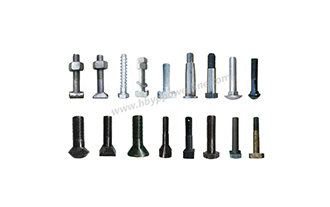Under normal circumstances, we analyze the bolt fracture from the following four aspects:
First, the quality of bolts
Second, the pre-tightening torque of the bolt
Third, the strength of the bolt
Fourth, the fatigue strength of the bolt
In fact, most cases of bolt breakage are caused by loosening and being broken due to loosening. Because the situation of bolt loosening and breaking is roughly the same as the situation of fatigue fracture, in the end, we can always find the reason for the fatigue strength. In fact, the fatigue strength is too big for us to imagine, and the fatigue strength of the bolt is not used at all during the use process.
01
Bolt fracture is not due to the tensile strength of the bolt
Take an M20×80 Grade 8.8 Bolt as an example. Its weight is only 0.2 kg, and its minimum tensile load is 20 tons, which is as high as 100,000 times its own weight. Under normal circumstances, we only Will use it to fasten 20 kg parts and only use one-thousandth of its maximum capacity. Even with the action of other forces in the equipment, it is impossible to break through a thousand times the weight of the component, so the tensile strength of the threaded fastener is sufficient, and it is impossible to be damaged due to the insufficient strength of the bolt.
02
The fracture of the Tension Bolt is not due to the fatigue strength of the bolt
Threaded fasteners can be loosened only one hundred times in the transverse vibration loosening experiment and one million times of repeated vibrations in the fatigue strength experiment. In other words, threaded fasteners become loose when they use one ten-thousandth of their fatigue strength. We only use one ten-thousandth of its capacity. Therefore, the looseness of threaded fasteners is not due to bolt fatigue strength.
03
The real cause of damage to threaded fasteners is looseness
After the threaded fastener is loosened, a huge kinetic energy mv2 is generated. This huge kinetic energy directly acts on the fastener and the equipment, causing the fastener to be damaged. After the fastener is damaged, the equipment cannot work under normal conditions, which further leads to Equipment damage.
For fasteners that are subjected to axial force, the threads are broken and the bolts are broken.
For fasteners under radial force, the bolts are cut and the bolt holes are punched into an oval.

Grade 8.8 Bolt
04
The choice of thread anti-loose method with the excellent anti-loose effect is the fundamental solution to the problem
Take a hydraulic hammer as an example. The weight of the GT80 hydraulic hammer is 1.663 tons. The side plate bolts are 7 sets of 10.9-grade M42 bolts. The tensile force of each bolt is 110 tons. The pre-tightening force is calculated as half of the tensile force. The pre-tightening force is as high as three or four hundred. Ton. But the bolts will break, and now I am going to change to M48 bolts. The root cause is that the bolts cannot be prevented from loosening.
When a bolt is broken, the easiest conclusion that people can draw is that the strength is not enough, so the method of increasing the strength grade of bolt diameter is mostly adopted. This method can increase the pre-tightening force of the bolt and its frictional force. Of course, the anti-loosening effect can also be improved, but this method is actually a non-professional method. It requires too much investment and too little benefit.
In short, the bolt is: "Don't loosen continuously, and break when loosened."
We are a Power Line Hardware supplier. If you are interested in our products, please feel free to contact us.
+86 319 878 9350
+86 156 1304 7999
+86 319 878 9350
NanYan, DongHuan Road, Shahe, Hebei China
Copyright © Hebei Yipeng Line Equipment Co., Ltd. All Rights Reserved. | Sitemap Powered By 
